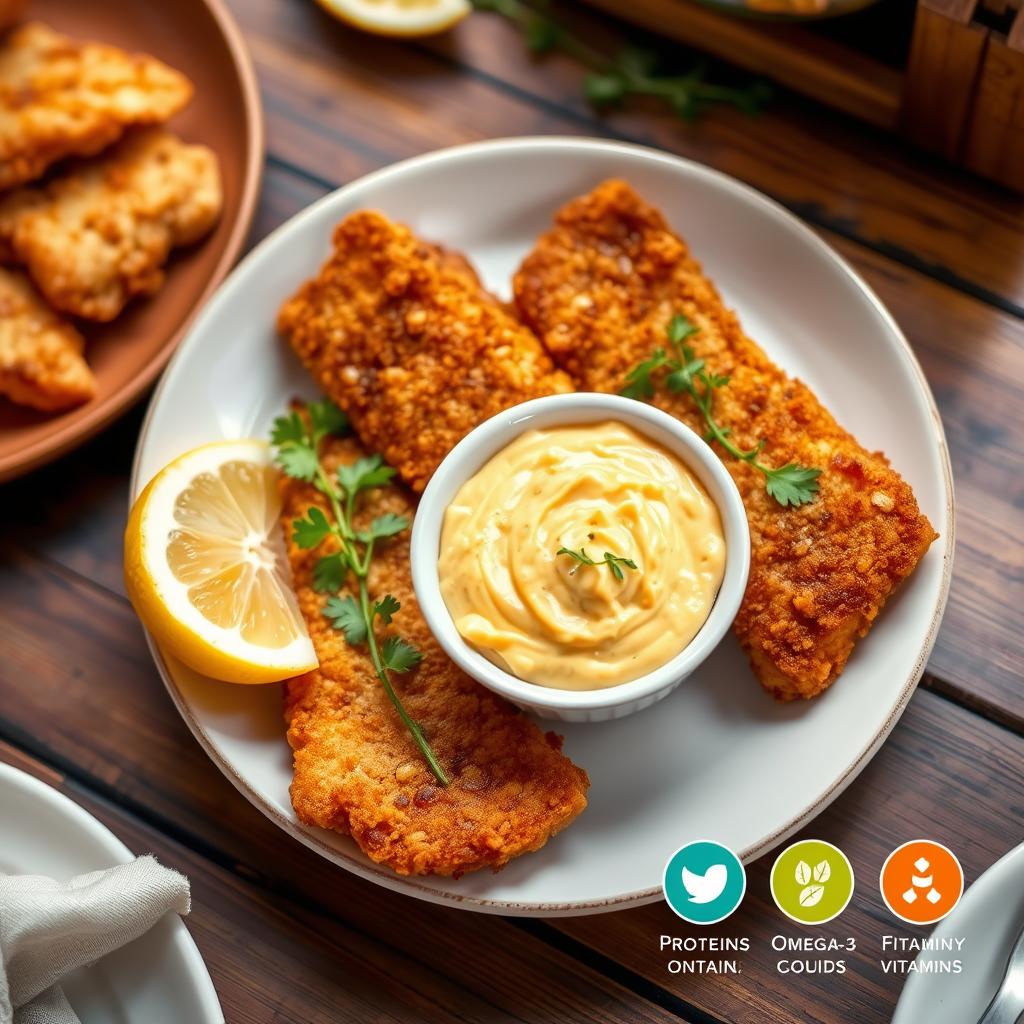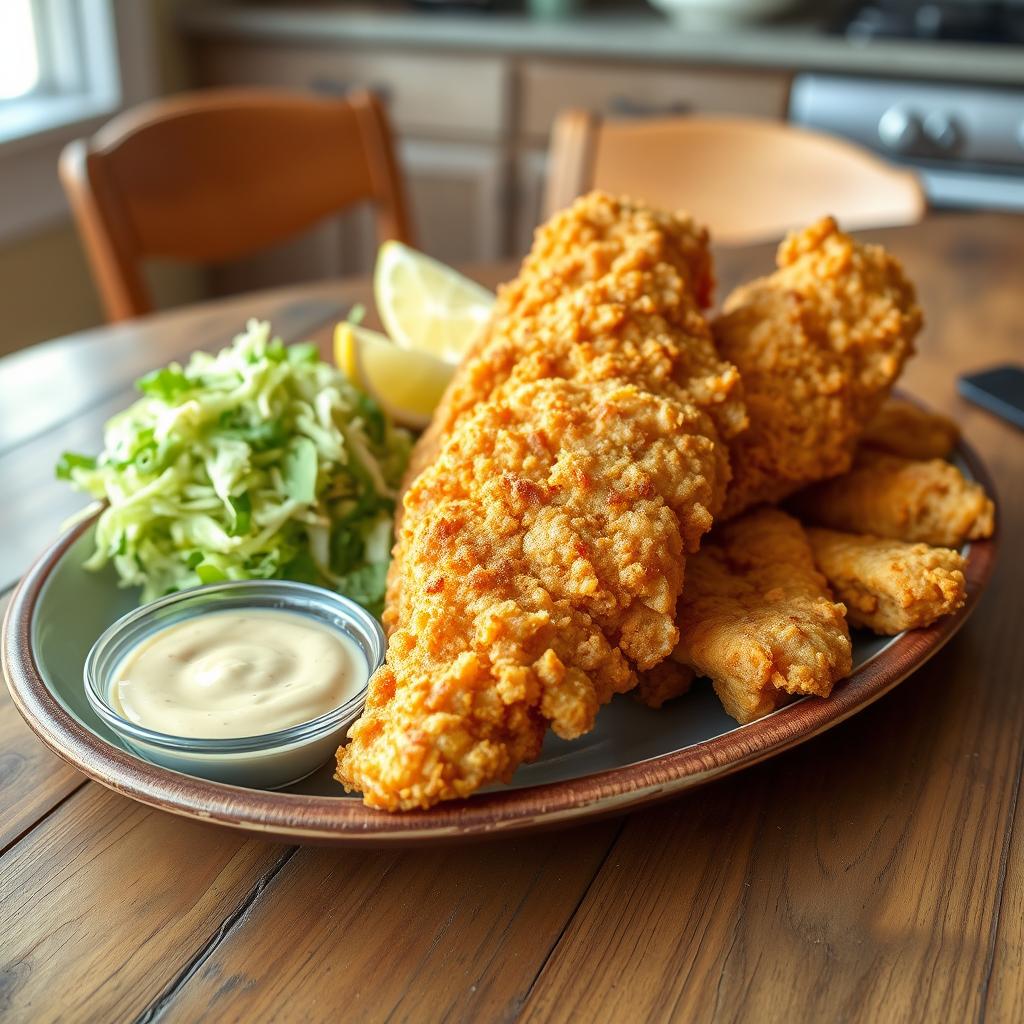Growing up in the South, the smell of fried catfish and Cajun remoulade was like the summer air. These tastes brought back memories of family times, laughter, and enjoying Southern food. Now, I’m here to teach you how to make this Louisiana classic in your own kitchen.
Key Takeaways
- Discover the essential ingredients for perfectly crispy fried catfish fillets.
- Learn the art of breading and frying catfish to achieve a golden-brown crust.
- Whip up a zesty Cajun remoulade sauce to complement the savory catfish.
- Explore tips and techniques for maintaining the warmth and crispiness of the fried catfish.
- Understand the nutritional benefits of incorporating catfish into your diet.
Essential Ingredients for Perfect Fried Catfish
To make the best fried catfish, start with the right ingredients. The heart of this recipe is the catfish fillets. Choose fresh, high-quality fillets cut into 1 ½-inch nuggets or strips for cooking.
Coat the catfish pieces with 1 tablespoon of Cajun seasoning. This adds a bold, authentic taste to the dish.
Selecting Quality Catfish Fillets
When picking catfish fillets, look for firm ones with a fresh smell. Avoid any that are discolored or smell strongly of fish. For the best flavor, refrigerate the catfish in buttermilk for at least 30 minutes, up to 8 hours.
Breading Components and Seasonings
The breading mixture is key to perfect fried catfish. It includes cornmeal, flour, Cajun seasoning, salt, garlic powder, and onion powder. Cornmeal adds crunch, while flour makes the outside crisp and golden. The Cajun seasoning, garlic, and onion powders give the catfish bold flavors.
Oil Selection for Frying
Choosing the right oil for frying is crucial. Use a high-heat tolerant oil like avocado, peanut, or vegetable oil. These oils can handle the high temperatures needed for a crispy crust. Avoid oils with low smoke points, as they can burn or add bad flavors.
| Ingredient | Quantity |
|---|---|
| Catfish Fillets | 1.5-2 pounds |
| All-Purpose Flour | 1 cup |
| Fine Cornmeal | 1/2 cup |
| Cajun Seasoning | 1 tablespoon |
| Eggs | 2 |
| Avocado Oil (or Peanut/Vegetable Oil) | For Frying |
“The key to delicious fried catfish lies in the perfect balance of seasoned breading and high-quality, fresh catfish fillets.”
Preparing Your Catfish for Frying
To make a tasty fried catfish dish, start by cleaning catfish fillets. Remove the dark fatty tissue and skin. Cut the fillets into 1.5-2 inch pieces or leave them whole, as you like.
Use paper towels to pat them dry well. This helps the coating stick better and get that crispy texture we all love.
Some recipes say to soak the catfish in milk for at least 30 minutes before breading. This step makes the fish taste milder and more delicate. After soaking, drain the fillets and season them lightly with salt and pepper. This gets them ready for the breading.
By carefully preparing your catfish, you’re setting up for a fantastic fried catfish dish. This step ensures the fish cooks evenly and gets that golden-brown crust we all want. With the catfish prepped and seasoned, you’re on your way to fried perfection.
The Art of Breading Catfish
Getting the perfect crunchy coating on fried catfish is a skill. It involves a three-step dredging process. This method makes sure the coating is even and flavorful, bringing out the fish’s natural taste.
Three-Step Dredging Process
- First, coat the catfish fillets in seasoned flour. This helps the breading stick to the fish.
- Next, dip the floured fillets in an egg wash. This is made by beating eggs with water and maybe a bit of hot sauce. The egg wash makes the final coating stick better.
- Finally, coat the fillets in cornmeal. The cornmeal gives the fish that crunchy texture and golden color when fried.
Let the breaded catfish rest in the fridge for about 15 minutes before frying. This step lets the coating set. It keeps it crisp during frying.
Seasoning Tips and Techniques
Seasoning is crucial for great-tasting fried catfish. Try mixing Cajun seasoning, garlic powder, and cayenne pepper for extra flavor. Adding herbs like thyme or parsley can also give a fresh taste.
Proper Coating Techniques
When breading, make sure to fully cover each fillet in flour, egg wash, and cornmeal. Shake off any extra to avoid a thick or clumpy coating. This way, you get a thin, even coating that crisps up well when fried.
“The key to perfectly crispy fried catfish is all in the breading. Follow this three-step process for a coating that’s out of this world.”
Mastering the Frying Temperature
To get the perfect fried catfish, you need to master the frying temperature. Keep the oil between 350°F to 375°F for the best results. A heavy-bottomed Dutch oven or cast iron skillet is great for even heat.
To check if the oil is ready, add a small amount of cornmeal breading. If it sizzles right away, it’s time to fry. Watch the temperature closely and adjust the heat to avoid smoking or burning.
The way you fry is key to a golden-brown crust. Carefully place the breaded catfish fillets in the hot oil. Fry them for 2 to 3 minutes on each side, flipping gently for even cooking.
Keeping the oil at the right temperature is crucial for crispy, golden-brown fried catfish. By mastering this, you’ll make the ultimate fried catfish. It will have a crunchy outside and a tender, flavorful inside.
Fried Catfish with Cajun Remoulade
Take your fried catfish to the next level with Cajun remoulade sauce. This Southern classic is a treat, with its delicate catfish and sweet taste.
Making the Perfect Remoulade Sauce
A great remoulade sauce needs bold flavors. It’s made with mayonnaise, Cajun seasonings, Creole mustard, and a bit of ketchup. This mix creates a creamy, tangy, and spicy sauce that’s perfect with fried catfish.
Serving Suggestions
Present the fried catfish hot, topped with Cajun remoulade and a lemon wedge. The sauce boosts the catfish’s flavor and offers a cool contrast to its crispy outside. Pair it with hush puppies or a fresh salad for a full meal.
For the best fried catfish, serve it right away. This ensures the perfect texture and taste. Enjoy the crispy catfish with the zesty, creamy Cajun remoulade sauce.
Tips for Achieving Golden-Brown Perfection
Getting crispy and evenly cooked fried catfish is an art. Focus on the frying time and temperature. Fry catfish nuggets for 2-3 minutes on each side. For fillets, fry for 3-4 minutes on each side until golden.
Make sure the fish doesn’t touch in the pan for even cooking. Overcrowding can make it steam instead of crisp. Fry in batches if you need to. The fish is done when it flakes easily and reaches 145°F (63°C). It should be opaque and flaky inside.
“The key to achieving that perfect crispy texture is all in the frying time and temperature. Follow the guidelines, and you’ll be rewarded with a golden-brown masterpiece every time.”
Here are more tips for a crispy texture and even cooking:
- Pat the catfish fillets dry before breading for better frying.
- Keep the oil temperature between 350-375°F for the best crispy texture and even cooking.
- Avoid overcrowding the pan to prevent uneven cooking and loss of crispy texture.

By following these tips, you’ll get golden-brown fried catfish every time. Enjoy the crispy outside and moist inside for a delicious seafood treat.
Storage and Reheating Guidelines
Enjoying fresh fried catfish is the best. But sometimes, you might have leftover catfish that needs to be stored and reheated right. It’s key to keep the taste, texture, and food safety in check.
Proper Storage Methods
For your leftover catfish to stay good and tasty, proper storage is a must. Let the fried catfish cool down completely. Then, put it in an airtight container in the fridge. Catfish nuggets can last up to 3 days this way.
If you want to keep it longer, freezing is an option. Cool the nuggets first, then put them in a freezer-safe bag or container. Store it in the freezer for up to 3 months. This keeps the texture and prevents freezer burn.
Best Reheating Practices
When reheating your leftover fried catfish, aim to keep the breading crispy. The best ways are to use an oven or air fryer.
- Oven Reheating: Heat your oven to 400°F (200°C). Place the fried catfish on a baking sheet. Reheat for 3-4 minutes, flipping halfway, until hot and crispy.
- Air Fryer Reheating: Set your air fryer to 400°F (200°C). Reheat the fried catfish for 3-4 minutes, shaking the basket now and then, until hot and crispy.
Don’t use the microwave to reheat fried catfish. It can make the breading soggy and ruin the texture.
By sticking to these storage and reheating guidelines, your leftover fried catfish will stay delicious and crispy. Even after being refrigerated or frozen. Proper handling and reheating ensure you enjoy your fried fish to the fullest.
Nutritional Information and Dietary Considerations
Fried catfish with Cajun remoulade is a hearty and flavorful dish. It has about 448 calories, 41g of protein, 22g of fat, and 18g of carbohydrates per serving. This makes it a great choice for muscle growth and repair.
It’s also a low-mercury fish, making it safe and healthy to eat often. Catfish is rich in B vitamins, vitamin D, selenium, and potassium. These nutrients are important for our bodies.
| Nutrient | Amount per Serving |
|---|---|
| Calories | 448 |
| Protein | 41g |
| Fat | 22g |
| Carbohydrates | 18g |
If you follow a gluten-free diet, you can easily make this dish gluten-free. Just use gluten-free baking flour instead of regular flour. This way, more people can enjoy the fried catfish and Cajun remoulade.
While catfish is nutritious, it’s important to watch out for mercury. Pregnant women, nursing mothers, and young children should be careful. The FDA has guidelines to keep seafood safe for everyone.

Conclusion
Fried Catfish with Cajun Remoulade is a true Southern comfort food. It highlights the lively tastes of Cajun cuisine. The dish, from the crispy catfish to the tangy remoulade sauce, reflects Louisiana’s rich food heritage.
Whether you’re eating at a top spot in Austin or making it at home, this dish celebrates Southern culinary creativity. Learning to fry catfish and make Cajun remoulade lets you enjoy Southern flavors at home. It brings the South’s warmth and hospitality to your table.
Keep exploring Southern comfort food, starting with fried catfish. It’s a dish filled with history, bold flavors, and a sense of community. Enjoy sharing it with loved ones. Bon appétit!
